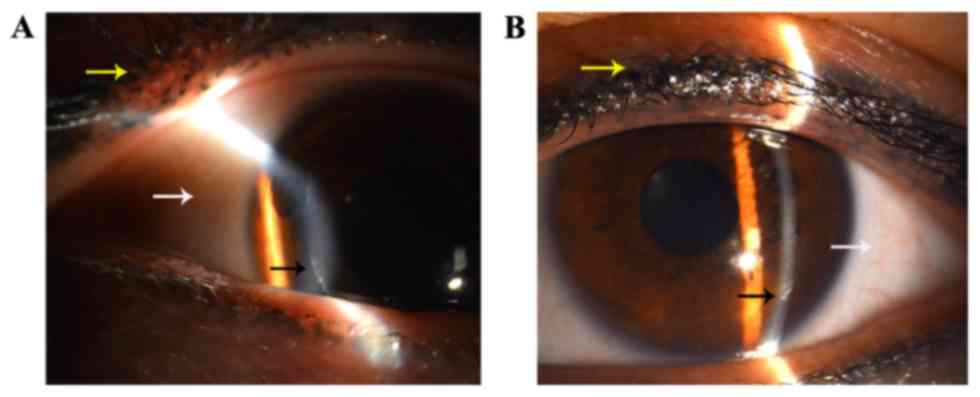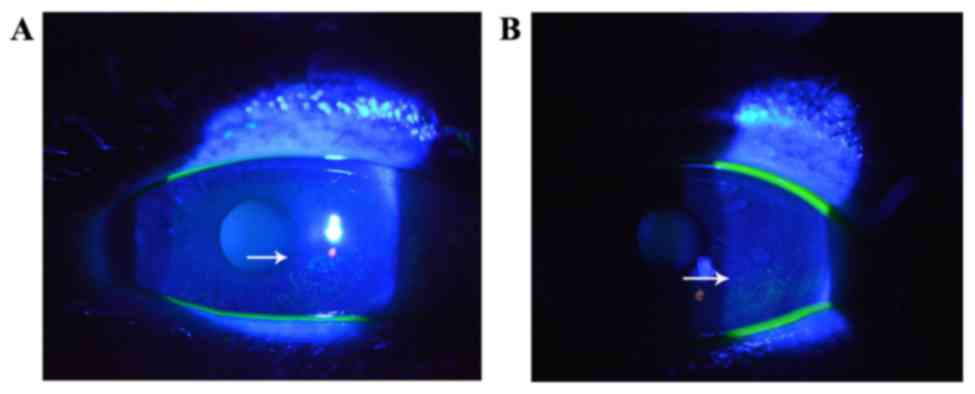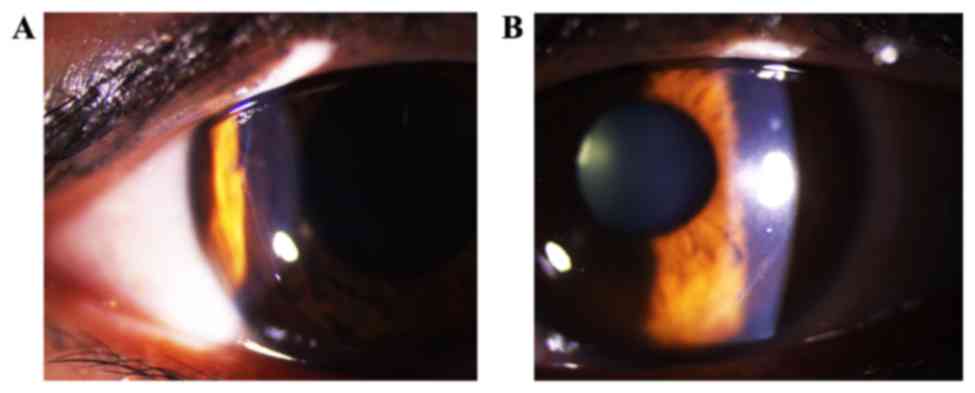Bilateral diffuse lamellar keratitis triggered by permanent eyeliner tattoo treatment: A case report
- Authors:
- Published online on: May 23, 2017 https://doi.org/10.3892/etm.2017.4506
- Pages: 283-285
-
Copyright: © Lu et al. This is an open access article distributed under the terms of Creative Commons Attribution License.
Abstract
Introduction
Permanent eyeliner tattoo application is a cosmetic periocular procedure that is increasing in popularity. However, it may encounter technical complications, such as pigment fanning, improper pigment placement, pigment migration and, on rare occasions, functional damage of the eyelid margin (1,2). Diffuse lamellar keratitis (DLK) is a common complication that may occur following laser-assisted in situ keratomileusis (LASIK) surgery, and is characterized by an inflammatory cellular response at the interface (2). However, limited cases of uveitis triggered by tattoo-related inflammation have been reported (3). Furthermore, little is known about ocular surface alterations and DLK resulting from permanent eyeliner tattoo treatment.
To the best of our knowledge, the present case report is the first to describe a case of DLK with late-onset, occurring 10 years after LASIK surgery, which was triggered by permanent eyeliner tattoo treatment. The objective in the present case report is to alert ophthalmologists to this complication of permanent eyeliner tattoo treatment as the popularity of this cosmetic procedure increases. Topical steroid therapy, artificial tears, autologous serum eye drops and timely surgical intervention are suggested to be important treatment options for patients with DLK.
Case report
A 37-year-old Chinese woman developed pain and severe foreign body sensation in both eyes 1 week after receiving bilateral permanent eyeliner tattoo treatment (Fig. 1) and presented to the Department of Ophthalmology, The First Hospital of Jilin University (Changchun, China) in September 2015. The patient provided written informed consent for her data to be used in this report. The patient's ocular history indicated she had received bilateral LASIK surgery 10 years prior to the incident. The patient denied any recent history of trauma and had no eye discomfort prior to the eyeliner tattoo application. On examination, her best-corrected vision was 20/20 bilaterally. Slit-lamp biomicroscopy revealed mild conjunctival congestion and punctate corneal epithelial erosions (Fig. 2), and diffused fine granular infiltrates precipitated around the edge of corneal flaps in both eyes (Fig. 1). No inflammation in the anterior chamber was observed. The remaining ophthalmic examination was normal. Routine laboratory screening tests (routine blood and urine tests, blood coagulation, liver function and kidney function) were all within normal limits. The patient was diagnosed with dry eye and DLK, and the patient was treated with topical 0.3% tobramycin/0.1% dexamethasone, artificial tears and 20% autologous serum three times per day.
After 1 week of treatment, the punctate corneal epithelial defects were resolved. However, epithelial ingrowth at the corresponding corneal flap edge remained unchanged. Therefore, the patient underwent surgery to remove the corneal epithelium around the DLK lesion. Epithelial ingrowth at the corresponding flap edge was no longer observed on the second postoperative day. The topical steroidal medication (0.1% fluorometholone) was gradually reduced over the next 3 weeks (three times a day for the first week, twice a day for the second week, once a day for the third week), while the artificial tears and autologous serum were continued as before surgery. No recurrence of the disease was detected during the 3-month observation period (Fig. 3).
Discussion
Permanent eyeliner tattoos have become increasingly common; however, certain complications of such tattoos have been reported in the ophthalmic literature (4). These include minor technical issues such as misapplication of the pigment with resultant anterior placement in the skin under the eyelashes, posterior placement in mucocutaneous tissue, poor distribution of the pigment and pigment fanning (4). More severe complications, such as cilia loss, eyelid scarring and infections have also been reported (4). Permanent eyeliner tattoo application may cause instability of the tear film and ocular surface disease through meibomian gland dysfunction and loss (5). Therefore, permanent eyeliner tattooing should be considered a risk factor for ocular surface diseases. It has been suggested that a delayed hypersensitivity reaction may occur secondary to localized immune sensitization to a particular pigment (6). The association of DLK with permanent eyeliner tattoo treatment is an unusual occurrence. To the best of our knowledge, this is the first case report describing a case of late-onset DLK, which was triggered by the application of a permanent eyeliner tattoo.
DLK is a common complication of LASIK surgery, since the creation of a flap provides a space in which cells are able to accumulate (7). DLK is characterized by diffused white, granular infiltrate around the edge of the corneal flap (7) and typically occurs within a few days after LASIK surgery. However, a previous report described a case where DLK occurred 12 years after LASIK surgery (8), although this is considered to be extremely rare. The present case study is the second case study to report late-onset DLK from LASIK surgery, appearing 10 years after LASIK treatment. The findings of the present case study and the previous study (8) indicate that DLK is able to manifest after an extended period of time following LASIK surgery.
Although the precise mechanism of DLK has not been fully elucidated, several possible etiologies, including peripheral immune infiltrates, atopic disease, ocular inflammatory disease, epithelial defects, bacterial endotoxins, chemicals or debris, surgical gloves and meibomian gland secretions have been reported (8,9). However, DLK resulting from permanent eyeliner tattooing in a post-LASIK patient has not been reported until now. Tattoo ink contains multiple coloring substances, including copper, mercury, iron, chromium, titanium (10) and p-phenylenediamine (11), which may provoke delayed hypersensitivity reactions (12). Tattoo pigments are known to activate mast cells and may provoke cellular lysis following phagocytosis (13). The histological appearance may vary from diffused lymphohistiocytic infiltrate (14) to pseudolymphomatous reactions (15), lichenoid reactions and sarcoidal granulomas (16). Intradermal injection of melanin, interphotoreceptor retinoid-binding protein and S-antigen have been demonstrated to produce severe posterior retinal uveitis (17). Cases of uveitis associated with tattoo inflammation have also been described in the literature (18–20). Tattoo-associated uveitis has been reported to resolve following tattoo excision or immunosuppression treatment with steroids, such as azathioprine or cyclosporine (21), indicating that immune reactions are involved in pigment-trigged uveitis. Although the literature for allergic reactions as a risk factor of LASIK surgery is limited, atopy has been suggested to be a patient-specific risk factor for the development of DLK, a potentially severe side effect following bilateral primary LASIK surgery (22). Previous studies have indicated that DLK may be triggered by peripheral immune infiltrates (23,24). Therefore, it is reasonable to postulate that the ink used in the permanent eyeliner tattoo procedure in the present case included chemicals that may provoke DLK. The underlying mechanism involved may be regulated through activating a local immunoreaction (25).
Although treatment recommendations for DLK have been documented, no trials have determined the optimal treatments. Mild-to-moderate inflammation is often treated with intensive topical steroids, whereas severe inflammation is typically treated by irrigating the interface and then administering intensive topical steroids. Although the patient in the present case study followed all of the doctor's instructions, the DLK did not improve. Unresolved DLK may progress to disintegration of the flap, which may lead to vision loss. Management of DLK includes lifting the flap and reducing the inflammatory reaction by careful irrigation of the bed and undersurface of the cap (22). In the present case, once the epithelial debris of the lesion was surgically removed, DLK improved markedly. The present findings indicate that when topical steroids failed to treat DLK, timely surgical intervention combined with topical steroids was a successful treatment. Artificial tears and autologous serum were used as treatments in the present case. Autologous serum has been demonstrated to be beneficial for corneal epithelial recovery, and has been used to treat diseases of the external eye, including keratoconjunctivitis sicca and persistent epithelial defects (26).
In conclusion, the present case indicates that permanent eyeliner tattoo treatment may serve as a potential trigger of late-onset of DLK, which in the present patient occurred 10 years after LASIK surgery. Topical steroid therapy, artificial tears, autologous serum eye drops and timely surgical intervention are important factors to consider when treating patients with DLK. Doctors should be aware of this complication associated with permanent eyeliner tattoo treatment as the popularity of this cosmetic procedure increases.
References
|
Hurwitz JJ, Brownstein S and Mishkin SK: Histopathological findings in blepharopigmentation (eyelid tattoo). Can J Ophthalmol. 23:267–269. 1988.PubMed/NCBI | |
|
Lin RT and Maloney RK: Flap complications associated with lamellar refractive surgery. Am J Ophthalmol. 127:129–136. 1999. View Article : Google Scholar : PubMed/NCBI | |
|
Saliba N, Owen ME and Beare N: Tattoo-associated uveitis. Eye (Lond). 24:14062010. View Article : Google Scholar : PubMed/NCBI | |
|
Vagefi MR, Dragan L, Hughes SM, Klippenstein KA, Seiff SR and Woog JJ: Adverse reactions to permanent eyeliner tattoo. Ophthal Plast Reconstr Surg. 22:48–51. 2006. View Article : Google Scholar : PubMed/NCBI | |
|
Lee YB, Kim JJ, Hyon JY, Wee WR and Shin YJ: Eyelid tattooing induces meibomian gland loss and tear film instability. Cornea. 34:750–755. 2015. View Article : Google Scholar : PubMed/NCBI | |
|
Sperry K: Tattoos and tattooing. Part II: Gross pathology, histopathology, medical complications, and applications. Am J Forensic Med Pathol. 13:7–17. 1992. View Article : Google Scholar : PubMed/NCBI | |
|
Gritz DC: LASIK interface keratitis: Epidemiology, diagnosis and care. Curr Opin Ophthalmol. 22:251–255. 2011. View Article : Google Scholar : PubMed/NCBI | |
|
Kamiya K, Ikeda T, Aizawa D and Shimizu K: A case of late-onset diffuse lamellar keratitis 12 years after laser in situ keratomileusis. Jpn J Ophthalmol. 54:163–164. 2010. View Article : Google Scholar : PubMed/NCBI | |
|
Zhao J, He L, Yao P, Shen Y, Zhou Z, Miao H, Wang X and Zhou X: Diffuse lamellar keratitis after small-incision lenticule extraction. J Cataract Refract Surg. 41:400–407. 2015. View Article : Google Scholar : PubMed/NCBI | |
|
Slater DN and Durrant TE: Tattoos: Light and transmission electron microscopy studies with X-ray microanalysis. Clin Exp Dermatol. 9:167–173. 1984. View Article : Google Scholar : PubMed/NCBI | |
|
Bourra H and Hassam B: Contact dermatitis after black henna tattoo. Pan Afr Med J. 14:1542013.(In French). PubMed/NCBI | |
|
Shavit I, Hoffmann Y, Shachor-Meyouhas Y and Knaani-Levinz H: Delayed hypersensitivity reaction from black henna tattoo manifesting as severe facial swelling. Am J Emerg Med. 26:515. e3–e4. 2008. View Article : Google Scholar | |
|
England RW, Vogel P and Hagan L: Immediate cutaneous hypersensitivity after treatment of tattoo with Nd:YAG laser: A case report and review of the literature. Ann Allergy Asthma Immunol. 89:215–217. 2002. View Article : Google Scholar : PubMed/NCBI | |
|
Blumental G, Okun MR and Ponitch JA: Pseudolymphomatous reaction to tattoos. Report of three cases. J Am Acad Dermatol. 6:485–488. 1982. View Article : Google Scholar : PubMed/NCBI | |
|
Taaffe A, Knight AG and Marks R: Lichenoid tattoo hypersensitivity. Br Med J. 1:616–618. 1978. View Article : Google Scholar : PubMed/NCBI | |
|
Goldstein AP: VII. Histologic reactions in tattoos. J Dermatol Surg Oncol. 5:896–900. 1979. View Article : Google Scholar : PubMed/NCBI | |
|
Moschos MM and Guex-Crosier Y: Retinal vasculitis and cystoid macular edema after body tattooing: A case report. Klin Monbl Augenheilkd. 221:424–426. 2004. View Article : Google Scholar : PubMed/NCBI | |
|
Mansour AM and Chan CC: Recurrent uveitis preceded by swelling of skin tattoos. Am J Ophthalmol. 111:515–516. 1991. View Article : Google Scholar : PubMed/NCBI | |
|
McElvanney AM and Sherriff SM: Uveitis and skin tattoos. Eye (Lond). 8:602–603. 1994. View Article : Google Scholar : PubMed/NCBI | |
|
Barabasi Z, Kiss E, Balaton G and Vajo Z: Cutaneous granuloma and uveitis caused by a tattoo. Wien Klin Wochenschr. 120:182008. View Article : Google Scholar : PubMed/NCBI | |
|
Jacob J and Van Calster J: Skin tattoos and the development of uveitis. Acta Ophthalmol. 91:e650–e652. 2013. View Article : Google Scholar : PubMed/NCBI | |
|
Bielory BP and O'Brien TP: Allergic complications with laser-assisted in-situ keratomileusis. Curr Opin Allergy Clin Immunol. 11:483–491. 2011. View Article : Google Scholar : PubMed/NCBI | |
|
Ambrósio R Jr, Periman LM, Netto MV and Wilson SE: Bilateral marginal sterile infiltrates and diffuse lamellar keratitis after laser in situ keratomileusis. J Refract Surg. 19:154–158. 2003.PubMed/NCBI | |
|
Singhal S, Sridhar MS and Garg P: Bilateral peripheral infiltrative keratitis after LASIK. J Refract Surg. 21:402–404. 2005.PubMed/NCBI | |
|
Liao JC, Proia AD, Ely PH and Woodward JA: Late-onset melanopenic hypomelanosis as a complication of cosmetic eyeliner tattoo. J Am Acad Dermatol. 69:e144–e146. 2013. View Article : Google Scholar : PubMed/NCBI | |
|
Poon AC, Geerling G, Dart JK, Fraenkel GE and Daniels JT: Autologous serum eyedrops for dry eyes and epithelial defects: Clinical and in vitro toxicity studies. Br J Ophthalmol. 85:1188–1197. 2001. View Article : Google Scholar : PubMed/NCBI |












